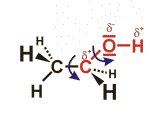 Alcohols
Alcohols
The alcohol group is formed by a hydroxy group connected to a carbon atom via a single covalent bond.
The structural formula of an alcohol containing two carbon atoms (ethanol) is given as an example. The influence of the oxygen atom leads to a partial positive charge of the carbon and hydrogen atom – this effect, however, is less pronounced when compared to the respective aldehyde. The covalent bonds connecting the two carbon atoms and the oxygen atom can rotate freely. Accordingly, there are many possible structures; the structure shown gives only one of these possibilities.
Regarding the sequence alcohol – aldehyde/ketone – carbonic acid, alcohols are least oxidized. They can be produced by reduction of the other compounds which, in turn, can be produced by oxidation of the respective alcohols. Thus, ethanol shown here can be produced from acetaldehyde or acetic acid.